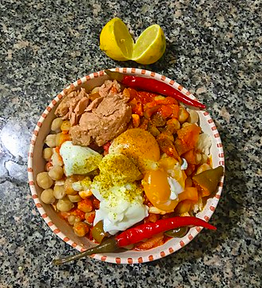
After we left the Dougga ruins, we went to Testour, a small town 30 minutes northeast of Dougga and over an hour away from Tunis. This town is 1,000 years old. It was originally a Berber town called Tichilla--meaning "green grass"--because it was a vast tapestry of fields and rivers. Things changed in the 17th century when Andalusian Muslims and Jews fled persecution in Spain and settled in what they would rename Testour. They also built some of the finest examples of Andalusian architecture in Tunisia that remain today.
The mosque was built with re-purposed Roman rocks to create the court and pillars. Inside the mosque are Andalusian arches and no windows. The roof has different shapes that do not resemble any other part, and the ceiling is highly decorated.
The mosque was made of limestone,
Spanish sand, and marble in addition to colored porcelain and tiles. It was sponsored by Muhammad Tigharinu, an Andalusian immigrant who settled in Testour in 1609.
One of the greatest achievements this mosque represents is that its architecture symbolizes religious tolerance that has distinguished Testour since the mosque was built in 1631. For example, the minaret incorporates several Islamic styles from different Muslim sects and a Star of David that figures prominently on two sides of the top in order to recognize Jewish community members who helped to build the city.
Rachid Soussi, president of the Association of the Protection of the Medina of Testour, said the mosque’s message of tolerance was unlike any others built during its period. It was meant to communicate that all were “welcome in the mosque. That it is a mosque for everyone.”
One more thing about the clock on the minaret. Its numbers have been placed in the opposite direction of what we usually see. There are several theories about why. One is that the earth turns in a counter-clockwise direction, and the architects wanted to be in sync with the Earth. Another is that the Andalusians wanted to return to Spain so they were in a sense turning the clock back to a time when they were there. Whatever the reason, the clock is one of three in the world like it, and it provides a unique and perhaps today a curious quality to the minaret. It's just one more reason to be fascinated by this little town with a long history.
The Andalusians also built a bathhouse that is still in operation today. It was also built in
1609. Its construction is a synthesis of local traditions and
Hispano-Moorish decorative and architectural techniques.
Capitalizing on its multicultural heritage, Testour houses a center on its proud heritage.
I found this manga on one of the walls of the street, which shows a modern slice of the city's intercultural nature. Manga is from the graphic novels from Japan, its spread obviously thanks to telecommunications and the Internet.
Testour also has a bit of a scandalous history. We poked our heads into the house of a famous Jewish singer of the 1920s, Habiba Msika. One of her married fans adored her so much that he built her this small palace in Testour. It had a performance hall and a large, imposing safe. Legend has it that she never lived in this house and her dejected lover killed her by setting fire to her house in Tunis. Scandals are ever-present in every culture. This one truly has a more dramatic history!

I got some good shots of people on the street. Here are a few good ones.


While we walked through the main drag of this little town, we took some time at a couple shops. We stopped at a cheese shop, which is a specialty product of Testour, and tasted three different cheeses: parsley, black garlic, and a third that tasted like ricotta cheese. We had a drink of fresh-squeezed pomegranate juice that was delicious and refreshing. And, we checked out a honey shop that featured a sticky, hardened candy with anise and nuts. This candy reminded me of my Sicilian heritage where my grandmother made something very similar to this candy. Over millennia, there were exchanges between Sicily and Tunisia. For the rest of this tour, I looked for other similarities in foods.


We also passed several roadside fruit and vegetable stands near and inside the town where people would stop their cars on the road and buy produce. As usual, the fruits and vegetables were displayed in picturesque ways. Usually the stands offered only one fruit or one vegetable.
We made our way back to Tunis after a long and info-packed day. A handful of people in the group went to a Tunisian jazz concert in the late afternoon. I took a much-needed rest in my hotel room and ate an apple and an orange for dinner. Later in the evening a few people went out to dinner for lablabi, a traditional winter dish where stale crusty bread is cut into small pieces, put in a garlic-and-cumin-flavored broth, and served with egg, tuna, chickpeas, and harissa sauce.
As with many of the places we visited in Tunisia, Testour was a big surprise for us given its history and an intriguing study of this small country that had served as a crossroads of many cultures.
Resources
Andalusians -- https://events.ceu.edu/2022-05-03/research-seminar-andalusians-tunisia-cultural-pride-and-privilege-longing-cultural
https://en.wikipedia.org/wiki/Great_Mosque_of_Testour
https://thearabweekly.com/testour-tunisias-symbol-religious-coexistence























No comments:
Post a Comment